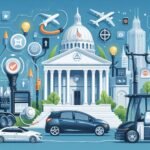Sustainability on Wheels: How Automakers Are Adapting to Green Technology
The automotive industry, a cornerstone of modern civilization, has long been associated with the consumption of fossil fuels and the emission of greenhouse gases. However, as environmental awareness and regulatory pressures intensify, automakers are undergoing a profound transformation. This metamorphosis towards sustainability is not merely a response to external pressures but a proactive step towards ensuring long-term viability and relevance. This article delves into the myriad ways in which automakers are integrating green technology, the challenges they face, and the broader implications for society and the environment.
The Drive Towards Electrification
The Rise of Electric Vehicles (EVs)
Electric vehicles (EVs) are at the forefront of the automotive industry’s green revolution. EVs produce zero tailpipe emissions, significantly reducing the carbon footprint compared to traditional internal combustion engine (ICE) vehicles. Leading automakers like Tesla, Nissan, and BMW have pioneered the EV market, demonstrating that sustainability and performance can coexist.
Tesla, arguably the most influential player in the EV space, has pushed the boundaries of what electric cars can achieve. The company’s focus on high-performance, long-range vehicles has shifted public perception, making EVs a viable alternative to conventional vehicles. Tesla’s Model S, Model 3, Model X, and Model Y have set benchmarks in terms of range, speed, and technological innovation.
Nissan’s Leaf, one of the best-selling electric cars globally, has made electric driving accessible to a broader audience. The Leaf’s success is indicative of a growing consumer willingness to embrace greener transportation options.
BMW’s i3 and i8 models showcase the brand’s commitment to sustainability without compromising on luxury and driving dynamics. The i3, with its carbon-fiber-reinforced plastic construction, exemplifies innovation in material science aimed at reducing vehicle weight and enhancing efficiency.
Expansion of Charging Infrastructure
The adoption of EVs is intrinsically linked to the availability of charging infrastructure. Automakers, in collaboration with governments and private enterprises, are investing heavily in expanding charging networks. Tesla’s Supercharger network, for instance, provides high-speed charging stations strategically located to facilitate long-distance travel.
Governments worldwide are also playing a crucial role by incentivizing the installation of charging stations. The European Union’s Green Deal includes substantial funding for the expansion of charging infrastructure, aiming to have at least one million public charging points by 2025. In the United States, the Biden administration has announced ambitious plans to build a national network of 500,000 EV chargers by 2030.
Battery Technology Advancements
The heart of an EV is its battery, and advancements in battery technology are critical to the widespread adoption of electric vehicles. Lithium-ion batteries, currently the industry standard, have seen significant improvements in energy density, cost, and longevity.
Automakers are investing in next-generation battery technologies to further enhance the viability of EVs. Solid-state batteries, which promise higher energy densities and improved safety, are being developed by companies like Toyota and BMW. These batteries could potentially offer greater range, faster charging times, and longer lifespans compared to current lithium-ion batteries.
Recycling and sustainable sourcing of battery materials are also key concerns. Companies are exploring ways to recycle used batteries and recover valuable materials like lithium, cobalt, and nickel. Additionally, efforts are being made to source these materials responsibly, minimizing the environmental and social impacts of mining.
Hydrogen Fuel Cells: The Alternative Path
While battery electric vehicles dominate the green technology discourse, hydrogen fuel cell vehicles (FCVs) present an alternative path towards zero-emission transportation. FCVs use hydrogen gas to produce electricity, emitting only water vapor as a byproduct.
Toyota, Hyundai, and Honda are leading the charge in hydrogen fuel cell technology. The Toyota Mirai and Hyundai Nexo are among the few commercially available FCVs, demonstrating the potential of hydrogen as a clean fuel source. These vehicles offer longer ranges and quicker refueling times compared to most battery electric vehicles, addressing some of the limitations associated with EVs.
Hydrogen infrastructure, however, remains a significant challenge. The production, storage, and distribution of hydrogen are complex and require substantial investment. Governments and private companies are working to develop hydrogen refueling networks, but widespread adoption is still in its nascent stages.
Lightweight Materials and Aerodynamics
Reducing the weight of vehicles is another critical aspect of improving fuel efficiency and reducing emissions. Automakers are increasingly utilizing lightweight materials such as aluminum, carbon fiber, and advanced composites in vehicle construction.
Aluminum, being lighter than steel, helps reduce vehicle weight, thereby improving fuel efficiency. Ford’s F-150, one of the best-selling trucks in the United States, uses an aluminum alloy body to achieve significant weight savings.
Carbon fiber, though more expensive, offers even greater weight reduction benefits. BMW’s i3 and i8 models use carbon-fiber-reinforced plastic (CFRP) extensively, demonstrating the potential of this material in producing lightweight, high-performance vehicles.
Aerodynamics also play a crucial role in vehicle efficiency. Reducing drag helps improve fuel economy and, in the case of EVs, extend battery range. Automakers employ advanced computer simulations and wind tunnel testing to optimize vehicle shapes and minimize aerodynamic drag.
Renewable Energy Integration
The automotive industry’s shift towards sustainability extends beyond the vehicles themselves. Automakers are increasingly integrating renewable energy sources into their manufacturing processes and operations.
Tesla’s Gigafactories, for example, are designed to be powered by renewable energy, with the goal of achieving carbon neutrality. The company’s Gigafactory 1 in Nevada features a vast rooftop solar array, while its Gigafactory 2 in New York focuses on solar panel production.
Volkswagen, as part of its “goTOzero” strategy, aims to achieve a carbon-neutral balance by 2050. The company is investing in renewable energy projects and has committed to using green electricity for its European manufacturing plants.
Circular Economy and Sustainable Practices
Embracing a circular economy is another significant trend in the automotive industry’s sustainability journey. This involves designing products and processes that minimize waste, promote recycling, and extend the lifecycle of materials.
BMW’s “MINI Recharged” program is an excellent example of circular economy principles in action. The program allows owners of classic Mini cars to retrofit them with electric drivetrains, extending the lifespan of these vehicles while reducing emissions.
Volvo, known for its commitment to safety and sustainability, is incorporating recycled materials into its vehicles. The company aims to use 25% recycled plastics in every new car by 2025 and is working towards making its entire manufacturing network climate-neutral.
Autonomous and Connected Vehicles
Autonomous and connected vehicle technologies are poised to revolutionize the automotive industry, with significant implications for sustainability. Self-driving cars have the potential to optimize traffic flow, reduce congestion, and lower emissions through more efficient driving patterns.
Waymo, Google’s autonomous vehicle subsidiary, has been testing self-driving cars for years, accumulating millions of miles of data. These vehicles use advanced sensors and algorithms to navigate complex urban environments, offering a glimpse into a future where human error is minimized, and efficiency is maximized.
Connected vehicle technologies enable cars to communicate with each other and with infrastructure, further enhancing efficiency. Vehicle-to-everything (V2X) communication can help reduce accidents, improve traffic management, and enable dynamic routing to avoid congestion.
Challenges and Obstacles
While the automotive industry is making significant strides towards sustainability, several challenges remain.
High Costs
The development and integration of green technologies often come with high costs. Advanced batteries, lightweight materials, and autonomous systems can significantly increase vehicle prices. While costs are expected to decrease over time with economies of scale and technological advancements, affordability remains a critical barrier for widespread adoption.
Infrastructure Development
The lack of sufficient charging and hydrogen refueling infrastructure is a significant hurdle for EV and FCV adoption. Building this infrastructure requires substantial investment and coordination between governments, automakers, and private enterprises.
Consumer Acceptance
Despite growing awareness of environmental issues, consumer acceptance of green vehicles is not universal. Concerns about range anxiety, charging times, and the perceived inconvenience of switching from traditional vehicles persist. Educating consumers and addressing these concerns is crucial for accelerating the transition to sustainable transportation.
Regulatory and Policy Support
Government policies and regulations play a vital role in driving the adoption of green technologies. Incentives such as tax credits, subsidies, and stringent emission standards can encourage both automakers and consumers to embrace sustainability. However, inconsistent policies and regulatory uncertainty can hinder progress.
The Road Ahead
The automotive industry’s journey towards sustainability is an ongoing process, with significant progress being made but much work still to be done. Collaboration between automakers, governments, and other stakeholders is essential to overcome the challenges and accelerate the adoption of green technologies.
Innovation and Research
Continued investment in research and development is critical for advancing green technologies. Breakthroughs in battery technology, hydrogen production, lightweight materials, and autonomous systems will play a crucial role in shaping the future of sustainable transportation.
Public-Private Partnerships
Public-private partnerships can facilitate the development of necessary infrastructure and promote the adoption of green vehicles. Collaborative efforts can help pool resources, share expertise, and create a supportive environment for sustainable innovation.
Consumer Education and Incentives
Educating consumers about the benefits of green vehicles and providing incentives can drive demand. Government policies that support the purchase and use of EVs and FCVs, coupled with public awareness campaigns, can accelerate the transition to sustainable transportation.
Holistic Approach to Sustainability
A holistic approach to sustainability involves considering the entire lifecycle of vehicles, from production to disposal. Automakers must continue to integrate renewable energy, adopt circular economy principles, and strive for carbon neutrality in their operations.
Conclusion
The automotive industry is undergoing a transformative shift towards sustainability, driven by the imperative to reduce environmental impact and adapt to changing consumer preferences and regulatory landscapes. Electric vehicles, hydrogen fuel cells, lightweight materials, renewable energy, and autonomous technologies are at the forefront of this green revolution.
While challenges remain, the progress made thus far is promising. The commitment of automakers, combined
with supportive government policies and growing consumer awareness, is paving the way for a more sustainable future on wheels. As innovation continues to drive the industry forward, the vision of a cleaner, greener transportation landscape is becoming an increasingly attainable reality.



طلب اداه تلفيل حساب ديسكورد
Et cass de lecture destinataire et peut
Google Google play et cass de 🤣 de
good panel
good
yes
Ty